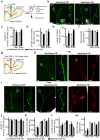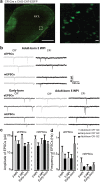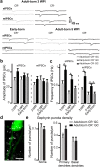The role of calretinin-expressing granule cells in olfactory bulb functions and odor behavior
- PMID: 29925844
- PMCID: PMC6010413
- DOI: 10.1038/s41598-018-27692-8
The role of calretinin-expressing granule cells in olfactory bulb functions and odor behavior
Abstract
The adult mouse olfactory bulb is continuously supplied with new neurons that mostly differentiate into granule cells (GCs). Different subtypes of adult-born GCs have been identified, but their maturational profiles and their roles in bulbar network functioning and odor behavior remain elusive. It is also not known whether the same subpopulations of GCs born during early postnatal life (early-born) or during adulthood (adult-born) differ in their morpho-functional properties. Here, we show that adult-born calretinin-expressing (CR+) and non-expressing (CR-) GCs, as well as early-born CR+ GCs, display distinct inhibitory inputs but indistinguishable excitatory inputs and similar morphological characteristics. The frequencies of inhibitory post-synaptic currents were lower in early-born and adult-born CR+ GCs than in adult-born CR- neurons. These findings were corroborated by the reduced density of gephyrin+ puncta on CR+ GCs. CR+ GCs displayed a higher level of activation following olfactory tasks based on odor discrimination, as determined by an immediate early gene expression analysis. Pharmacogenetic inhibition of CR+ GCs diminished the ability of the mice to discriminate complex odor mixtures. Altogether, our results indicate that distinct inhibitory inputs are received by adult-born CR+ and CR- GCs, that early- and adult-born CR+ neurons have similar morpho-functional properties, and that CR+ GCs are involved in complex odor discrimination tasks.
Conflict of interest statement
The authors declare no competing interests.
Figures






Similar articles
-
Calretinin-Expressing Neurons in the Basal Forebrain Specifically Contact Granule Cells in the Olfactory Bulb and Modulate Odor Learning.J Neurosci. 2025 Mar 5;45(10):e1867232024. doi: 10.1523/JNEUROSCI.1867-23.2024. J Neurosci. 2025. PMID: 39837663
-
A Subtype of Olfactory Bulb Interneurons Is Required for Odor Detection and Discrimination Behaviors.J Neurosci. 2016 Aug 3;36(31):8210-27. doi: 10.1523/JNEUROSCI.2783-15.2016. J Neurosci. 2016. PMID: 27488640 Free PMC article.
-
Activity of the principal cells of the olfactory bulb promotes a structural dynamic on the distal dendrites of immature adult-born granule cells via activation of NMDA receptors.J Neurosci. 2014 Jan 29;34(5):1748-59. doi: 10.1523/JNEUROSCI.3013-13.2014. J Neurosci. 2014. PMID: 24478357 Free PMC article.
-
The Functional Role of Olfactory Bulb Granule Cell Subtypes Derived From Embryonic and Postnatal Neurogenesis.Front Mol Neurosci. 2018 Jul 5;11:229. doi: 10.3389/fnmol.2018.00229. eCollection 2018. Front Mol Neurosci. 2018. PMID: 30034321 Free PMC article. Review.
-
Newborn neurons in the adult olfactory bulb: unique properties for specific odor behavior.Behav Brain Res. 2012 Feb 14;227(2):480-9. doi: 10.1016/j.bbr.2011.08.001. Epub 2011 Aug 6. Behav Brain Res. 2012. PMID: 21843557 Review.
Cited by
-
Moderate prenatal alcohol exposure alters the number and function of GABAergic interneurons in the murine orbitofrontal cortex.Alcohol. 2020 Nov;88:33-41. doi: 10.1016/j.alcohol.2020.06.001. Epub 2020 Jun 12. Alcohol. 2020. PMID: 32540413 Free PMC article.
-
New Neurons in the Postnatal Olfactory System: Functions in the Healthy and Regenerating Brain.Brain Sci. 2025 Jun 2;15(6):597. doi: 10.3390/brainsci15060597. Brain Sci. 2025. PMID: 40563769 Free PMC article. Review.
-
Developmental Potential and Plasticity of Olfactory Epithelium Stem Cells Revealed by Heterotopic Grafting in the Adult Brain.Stem Cell Reports. 2020 Apr 14;14(4):692-702. doi: 10.1016/j.stemcr.2020.03.008. Epub 2020 Apr 2. Stem Cell Reports. 2020. PMID: 32243847 Free PMC article.
-
Olfactory neurogenesis plays different parts at successive stages of life, implications for mental health.Front Neural Circuits. 2024 Aug 8;18:1467203. doi: 10.3389/fncir.2024.1467203. eCollection 2024. Front Neural Circuits. 2024. PMID: 39175668 Free PMC article. Review.
-
Development of the mammalian main olfactory bulb.Development. 2022 Feb 1;149(3):dev200210. doi: 10.1242/dev.200210. Epub 2022 Feb 11. Development. 2022. PMID: 35147186 Free PMC article. Review.
References
Publication types
MeSH terms
Substances
Grants and funding
LinkOut - more resources
Full Text Sources
Other Literature Sources
Molecular Biology Databases
Miscellaneous

